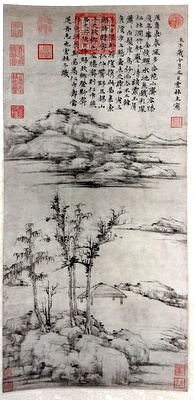Difference between revisions of "Ni Zan"
m |
|||
| Line 1: | Line 1: | ||
| + | [[File:Nizan.jpg|right|thumb|400px|"The Rongxi Studio," [[1372]]]] | ||
*''Born: [[1301]]'' | *''Born: [[1301]]'' | ||
*''Died: [[1374]]'' | *''Died: [[1374]]'' | ||
Latest revision as of 02:36, 12 March 2018

Ni Zan was a Chinese ink painter of the Yuan Dynasty. He is regarded as one of the greatest painters of his time. He is known especially for his sparse landscapes devoid of human figures.
Ni Zan was born into a wealthy land-owning family, and once he inherited the family fortune, he built up an extensive collection of books, paintings and works of calligraphy. Despite his wealth, in his paintings, he was an important predecessor to the literati painting tradition, painting scenes of remote rural retreat and retirement. Further, he and his contemporaries, such as Zhao Mengfu, represent an important art historical step towards later, Ming Dynasty, developments in the embrace of privileging expressive line, symbolic representation, and a feigned amateurishness of depiction, over realistic recreation.
In the latter years of the Yuan Dynasty, Ni Zan fled from rebel uprisings, seeking safety by living on a houseboat.
References
- Valerie Hansen, The Open Empire, New York: W.W. Norton & Company (2000), 363-365, 367.